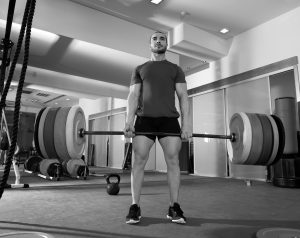Introduction
For individuals who have never trained using weights before the prospect of starting can be quite intimidating. Not knowing what exercises to do for what muscle group or not knowing how long to train and how often are common reasons why people will never even start. This guide provides gym exercises for beginners and with the natural progression of this plan it can also be useful for intermediate gym users alike. With an easy to follow plan the guide can be a useful tool to get you started.

Common problems that influence your progress
The most common gripe that individuals have when it comes to weight training are usually along the lines of “why aren’t my muscles getting bigger?” or “why am I not seeing any progress?” This lack of progress could be down to a number of factors. The main ones are listed below and along with it a snippet of advice that might help overcome these issues.
Diet- calories and macronutrients
In simple terms calories are the units of energy that are stored in food and when consumed can release energy for movement. If we consume more calories than the body needs then we put on weight, if we consume less than the body needs we lose weight. When we exercise e.g. weight training, calories are burned not only for muscle contraction during the session but also used in the repairing process through consuming macronutrients made up of carbohydrates fats and proteins. If during the period of following a training programme you do not consume enough calories through a good balance of these macronutrients, you will struggle to gain muscle mass and therefore will not see a difference in body shape.
As mentioned above Macronutrients are made up of carbohydrates fats and proteins and their role within the body varies:
Carbohydrate- The body’s primary energy source- and building new muscle requires surplus energy. Having more energy (consuming more calories) than your body uses is a key factor when it comes to building muscle. Carbohydrates are stored in the liver and also in the muscles therefore you can see how it can help build muscle. However consuming too much carbohydrate when not training can result in this excess carbohydrate converting to fat and therefore leads to weight gain.
Fats- Fats are extremely important for various bodily functions including the production of hormones in particular testosterone which is a hormone that can help with the muscle building process. Fats have an energy density of 9 calories per gram so also play an important role when it comes to fuelling our body for exercise.
Protein- Protein is used to repair, maintain and build muscle. If you are wanting to build muscle through weight training it is essential that you are consuming the right balance of protein as part of your diet.
It can be quite difficult to get a perfect balance of these macronutrients in order to build and maintain muscle; however the table below may give you an indication of the amount of calories and macronutrients you should be consuming in order to build muscle. The example below is based on healthy individuals and the calories and macronutrients they would need to start building muscle based on their weight.
|
Your weight (kg) |
Daily Total (kcal) | Protein (grams) | Fats (grams) |
Carbohydrates (grams) |
|
50 |
1750 | 150 | 39 |
200 |
|
55 |
1910 | 165 | 42 |
217 |
|
60 |
2070 | 180 | 46 |
234 |
|
65 |
2240 | 195 | 50 |
253 |
|
70 |
2400 | 210 | 53 |
270 |
|
75 |
2560 | 225 | 57 |
287 |
|
80 |
2720 | 240 | 60 |
304 |
|
85 |
2880 | 255 | 64 |
321 |
|
90 |
3050 | 270 | 68 |
340 |
Training- intensity and frequency- As with anything in life the more consistent you are and the more you do something the better you get. Weight training is no different. It is important to stick with a plan and always work as hard as you can during these sessions. By doing this you will become more confident and will feel better about yourself and your training.
Patience- Throughout a training plan it is always important to remain patient. Too many people give up after as little as a week just because they think they are not progressing. On average, it takes between 8-12 weeks to start seeing any difference in regards to muscle size.
5×5 training
This guide is an introduction to a style of weight training known as 5×5. 5×5 training, if done correctly will help improve your strength and can help build muscle. This type of training is split in to 2 weeks (week A and week B) which are repeated over at least an 8 week period. You will train three days a week and each session is made up of 3 exercises in which you will complete 5 sets of each exercise with 5 reps in each set. Try and miss one day in between each session e.g. train Monday, Wednesday, and Friday.
Whenever you complete the same exercise in the next session you should add 2.5kg on provided you completed 5 reps comfortably the first time around for that particular exercise. For example, if in your first session you start by squatting 50kg comfortably and successfully, then the next session you should attempt squatting 52.5kg. If you struggle to complete 5 reps on each set of a particular weight, start on the same weight in the next session. Below is a template that you can follow.
Note: This is just an example of the weight used, make sure you start with an appropriate weight that suits your ability otherwise injury can occur.
|
Week A 5×5 |
|||
|
Day 1 |
|||
|
Exercise |
Sets | Reps |
Weight (kg) |
|
Squat |
5 | 5 |
50 |
|
Dumbbell press |
5 | 5 |
20 (each arm) |
|
Barbell row |
5 | 5 |
30 |
|
Week A 5×5 |
|||
|
Day 2 |
|||
| Exercise | Sets | Reps |
Weight (kg) |
|
Squat |
5 | 5 | 52.5 |
|
Overhead Press |
5 | 5 |
30 |
| Deadlift | 5 | 5 |
50 |
|
Week A 5×5 |
|||
|
Day 3 |
|||
|
Exercise |
Sets | Reps |
Weight (kg) |
|
Squat |
5 | 5 |
55 |
|
Dumbbell Press |
5 | 5 |
22.5 (each arm) |
| Barbell row | 5 | 5 |
32.5 |
|
Week B 5×5 |
|||
|
Day 1 |
|||
|
Exercise |
Sets | Reps |
Weight (kg) |
|
Squat |
5 | 5 |
57.5 |
|
Overhead Press |
5 | 5 |
32.5 |
|
Deadlift |
5 | 5 |
52.5 |
|
Week B 5×5 |
|||
|
Day 2 |
|||
|
Exercise |
Sets | Reps |
Weight (kg) |
|
Squat |
5 | 5 |
60 |
|
Dumbbell Press |
5 | 5 |
25 (each arm) |
|
Barbell row |
5 | 5 |
35 |
|
Week B 5×5 |
|||
|
Day 3 |
|||
|
Exercise |
Sets | Reps |
Weight (kg) |
|
Squat |
5 | 5 |
62.5 |
|
Overhead Press |
5 | 5 |
35 |
|
Deadlift |
5 | 5 |
55 |

FAQs
- What is more important: Technique or weight?
Learning to lift weights using the correct technique is essential when starting out or committing yourself to a training programme. Incorrect technique can lead to injury and also can affect your progress as you might not be engaging the correct muscles for a particular exercise. If you are a complete beginner a good idea might be to take one session to practice the technique of these exercises e.g. having no weight on the bar. Also seek out advice from a trainer at your gym.
- What if you miss a workout?
This can be easily done as we have other things going on besides training. If this happens either just accept it and move on or try and complete your session another day in the week.
- Can you incorporate other exercises in to this guide?
Of course, this is a simple easy to follow guide covering exercises that will help improve strength and build muscle over time, if you feel you want to incorporate other muscle groups in to this over 8 weeks then use the same principle with your added exercise.
- Are there supplements I can take to help with my training?
There are hundreds of supplements on the market that claim to help your progress in the gym; the majority of them are usually a waste of money. A good protein powder from a reputable website or company will be just fine to aid your muscle recovery. You could look at investing in BCAA’s (branched chain amino acids) which also help with muscle recovery and can be used alongside protein. Otherwise just ensure you are getting enough protein in your daily diet from food.
